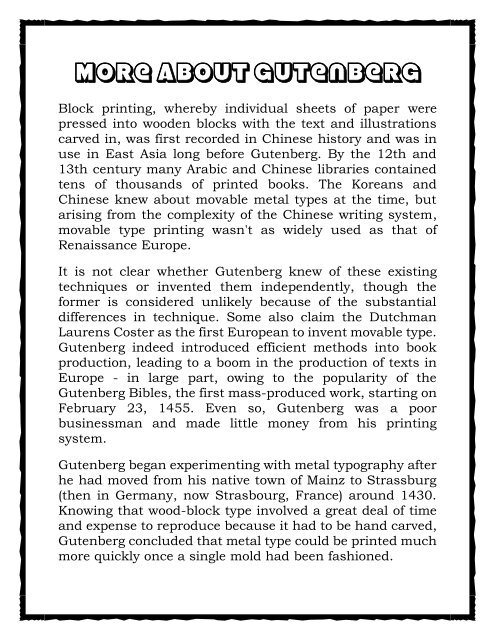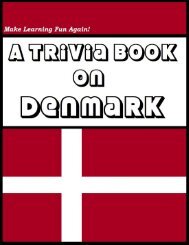A Trivia Book on Gutenberg
You are Johannes Gutenberg, and your assistant is Peter Schoeffer. You have managed to acquire an investor by the name of Johann Fust. He is not a patient man, yet he has shown quite an interest in your discovery. With the investment given to you, you set up a workshop in Mainz and begin to take on the task of finding a way to print books faster than those that handwrite them. It will depend on your knowledge to determine if your ambitious goal of printing over 180 Bibles in a 5-year period will succeed. Answer 20 trivia questions to see how Johannes Gutenberg will manage. After the initial story, enjoy a crossword and word search puzzle. Thank you for reading a Trivia Gamebook!
You are Johannes Gutenberg, and your assistant is Peter Schoeffer. You have managed to acquire an investor by the name of Johann Fust. He is not a patient man, yet he has shown quite an interest in your discovery. With the investment given to you, you set up a workshop in Mainz and begin to take on the task of finding a way to print books faster than those that handwrite them. It will depend on your knowledge to determine if your ambitious goal of printing over 180 Bibles in a 5-year period will succeed. Answer 20 trivia questions to see how Johannes Gutenberg will manage. After the initial story, enjoy a crossword and word search puzzle. Thank you for reading a Trivia Gamebook!
You also want an ePaper? Increase the reach of your titles
YUMPU automatically turns print PDFs into web optimized ePapers that Google loves.
More About <strong>Gutenberg</strong><br />
Block printing, whereby individual sheets of paper were<br />
pressed into wooden blocks with the text and illustrati<strong>on</strong>s<br />
carved in, was first recorded in Chinese history and was in<br />
use in East Asia l<strong>on</strong>g before <strong>Gutenberg</strong>. By the 12th and<br />
13th century many Arabic and Chinese libraries c<strong>on</strong>tained<br />
tens of thousands of printed books. The Koreans and<br />
Chinese knew about movable metal types at the time, but<br />
arising from the complexity of the Chinese writing system,<br />
movable type printing wasn't as widely used as that of<br />
Renaissance Europe.<br />
It is not clear whether <strong>Gutenberg</strong> knew of these existing<br />
techniques or invented them independently, though the<br />
former is c<strong>on</strong>sidered unlikely because of the substantial<br />
differences in technique. Some also claim the Dutchman<br />
Laurens Coster as the first European to invent movable type.<br />
<strong>Gutenberg</strong> indeed introduced efficient methods into book<br />
producti<strong>on</strong>, leading to a boom in the producti<strong>on</strong> of texts in<br />
Europe - in large part, owing to the popularity of the<br />
<strong>Gutenberg</strong> Bibles, the first mass-produced work, starting <strong>on</strong><br />
February 23, 1455. Even so, <strong>Gutenberg</strong> was a poor<br />
businessman and made little m<strong>on</strong>ey from his printing<br />
system.<br />
<strong>Gutenberg</strong> began experimenting with metal typography after<br />
he had moved from his native town of Mainz to Strassburg<br />
(then in Germany, now Strasbourg, France) around 1430.<br />
Knowing that wood-block type involved a great deal of time<br />
and expense to reproduce because it had to be hand carved,<br />
<strong>Gutenberg</strong> c<strong>on</strong>cluded that metal type could be printed much<br />
more quickly <strong>on</strong>ce a single mold had been fashi<strong>on</strong>ed.










